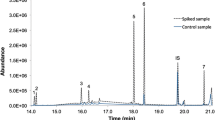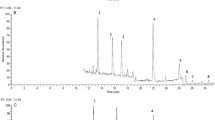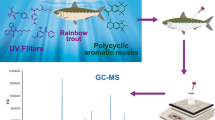Abstract
A sensitive and selective quick, easy, cheap, effective, rugged, and safe (QuEChERS) extraction combined with dispersive solid-phase extraction (d-SPE) cleanup method was developed to simultaneously extract a wide range of personal care products (16 biocides, 4 synthetic musks, and 4 benzotriazoles) in fish muscle and liver tissues. In order to get satisfactory recoveries, different extraction parameters were optimized, including extraction salts and d-SPE materials, extraction solvents and acetic acid contents in organic phase, and the ratios of solvent and water. Ultra pressure liquid chromatography-tandem mass spectrometry and gas chromatography-mass spectrometry were used to analyze the target compounds in the extracts. Among the 24 personal care products, the recoveries in the range of 70–120 % were obtained for 20, 19, and 12 analytes in fish muscle at the spiking concentrations of 10, 5, and 1 ng/g ww, respectively, and for 13, 12, and 11 analytes in liver at the spiking concentrations of 40, 20, and 4 ng/g ww, respectively. Method quantification limits (MQLs) of all analytes were 0.02–2.12 ng/g ww for fish muscle and 0.22–12.2 ng/g ww for fish liver tissues. The method was successfully applied to wild fish samples collected from Dongjiang River, south China. Twenty-one and 17 of the analytes were found in fish muscle and liver samples, respectively, in at least one site of the river with the concentrations between below MQLs and 119 ng/g ww, respectively.

Achieved satisfactory recoveries, high precision, and low method quantification limits (MQLs) for PCPs in wild fish tissues by QuEChERS procedure optimization combined with UPLC-MS/MS and GC-MS analyses







Similar content being viewed by others
References
Petrie B, Barden R, Kasprzyk-Hordern B. A review on emerging contaminants in wastewaters and the environment: current knowledge, understudied areas and recommendations for future monitoring. Water Res. 2015;72:3–27.
Hahn S, Schneider K, Gartiser S, Heger W, Mangelsdorf I. Consumer exposure to biocides—identification of relevant sources and evaluation of possible health effects. Environ Health. 2010;9:1.
Giger W, Schaffner C, Kohler H-PE. Benzotriazole and tolyltriazole as aquatic contaminants. 1. Input and occurrence in rivers and lakes. Environ Sci Technol. 2006;40:7186–92.
Nakata H, Hinosaka M, Yanagimoto H. Macrocyclic-, polycyclic-, and nitro musks in cosmetics, household commodities and indoor dusts collected from Japan: implications for their human exposure. Ecotoxicol Environ Saf. 2015;111:248–55.
EC (European Communities). Scientific Committee on Emerging and Newly Identified Health Risks (Effects of Biocides on antibiotic resistance). In: DG Health and Consumers of the European Commission. 2009. http://ec.europa.eu/health/opinions/en/biocides-antibiotic-resistance/biocides-antibiotic-resistance-greenfacts-level2.pdf. accessed 30 July 2016.
Lignell S, Darnerud PO, Aune M, Cnattingius S, Hajslova J, Setkova L, et al. Temporal trends of synthetic musk compounds in mother’s milk and associations with personal use of perfumed products. Environ Sci Technol. 2008;42:6743–8.
Chen Z-F, Ying G-G. Occurrence, fate and ecological risk of five typical azole fungicides as therapeutic and personal care products in the environment: a review. Environ Int. 2015;84:142–53.
Yang GCC, Tsai H-J, Chang F-K. Occurrence of triclosan in the tropical rivers receiving the effluents from the hospital wastewater treatment plant. Environ Monit Assess. 2015;187:1–8.
Clara M, Gans O, Windhofer G, Krenn U, Hartl W, Braun K, et al. Occurrence of polycyclic musks in wastewater and receiving water bodies and fate during wastewater treatment. Chemosphere. 2011;82:1116–23.
Liu Y-S, Ying G-G, Shareef A, Kookana RS. Occurrence and removal of benzotriazoles and ultraviolet filters in a municipal wastewater treatment plant. Environ Pollut. 2012;165:225–32.
Ngoc Han T, Li J, Hu J, Ong SL. Occurrence and suitability of pharmaceuticals and personal care products as molecular markers for raw wastewater contamination in surface water and groundwater. Environ Sci Pollut Res. 2014;21:4727–40.
Chase DA, Karnjanapiboonwong A, Fang Y, Cobb GP, Morse AN, Anderson TA. Occurrence of synthetic musk fragrances in effluent and non-effluent impacted environments. Sci Total Environ. 2012;416:253–60.
Zhang Z, Ren N, Li Y-F, Kunisue T, Gao D, Kannan K. Determination of benzotriazole and benzophenone UV filters in sediment and sewage sludge. Environ Sci Technol. 2011;45:3909–16.
Zhao J-L, Zhang Q-Q, Chen F, Wang L, Ying G-G, Liu Y-S, et al. Evaluation of triclosan and triclocarban at river basin scale using monitoring and modeling tools: implications for controlling of urban domestic sewage discharge. Water Res. 2013;47:395–405.
Tamura I, Kagota K-i, Yasuda Y, Yoneda S, Morita J, Nakada N, et al. Ecotoxicity and screening level ecotoxicological risk assessment of five antimicrobial agents: triclosan, triclocarban, resorcinol, phenoxyethanol and p-thymol. J Appl Toxicol. 2013;33:1222–9.
Carlsson G, Norrgren L. Synthetic musk toxicity to early life stages of zebrafish (Danio rerio). Arch Environ Contam Toxicol. 2004;46:102–5.
Liang X, Wang M, Chen X, Zha J, Chen H, Zhu L, et al. Endocrine disrupting effects of benzotriazole in rare minnow (Gobiocypris rarus) in a sex-dependent manner. Chemosphere. 2014;112:154–62.
Taxvig C, Vinggaard AM, Hass U, Axelstad M, Metzdorff S, Nellemann C. Endocrine-disrupting properties in vivo of widely used azole fungicides. Int J Androl. 2008;31:170–6.
Schreurs R, Sonneveld E, Jansen JHJ, Seinen W, van der Burg B. Interaction of polycyclic musks and UV filters with the estrogen receptor (ER), androgen receptor (AR), and progesterone receptor (PR) in reporter gene bioassays. Toxicol Sci. 2005;83:264–72.
Stadnicka J, Schirmer K, Ashauer R. Predicting concentrations of organic chemicals in fish by using toxicokinetic models. Environ Sci Technol. 2012;46:3273–80.
Ruedel H, Boehmer W, Mueller M, Fliedner A, Ricking M, Teubner D, et al. Retrospective study of triclosan and methyl-triclosan residues in fish and suspended particulate matter: results from the German Environmental Specimen Bank. Chemosphere. 2013;91:1517–24.
Nakata H, Sasaki H, Takemura A, Yoshioka M, Tanabe S, Kannan K. Bioaccumulation, temporal trend, and geographical distribution of synthetic musks in the marine environment. Environ Sci Technol. 2007;41:2216–22.
Chuang Y-H, Zhang Y, Zhang W, Boyd SA, Li H. Comparison of accelerated solvent extraction and quick, easy, cheap, effective, rugged and safe method for extraction and determination of pharmaceuticals in vegetables. J Chromatogr A. 2015;1404:1–9.
Masia A, Vasquez K, Campo J, Pico Y. Assessment of two extraction methods to determine pesticides in soils, sediments and sludges. Application to the Turia River Basin. J Chromatogr A. 2015;1378:19–31.
Anastassiades M, Lehotay SJ, Stajnbaher D, Schenck FJ. Fast and easy multiresidue method employing acetonitrile extraction/partitioning and “dispersive solid-phase extraction” for the determination of pesticide residues in produce. J AOAC Int. 2003;86:412–31.
Prestes OD, Antonio Padilla-Sanchez J, Romero-Gonzalez R, Lopez Grio S, Garrido Frenich A, Martinez-Vidal JL. Comparison of several extraction procedures for the determination of biopesticides in soil samples by ultrahigh pressure LC-MS/MS. J Sep Sci. 2012;35:861–8.
Rouviere F, Bulete A, Cren-Olive C, Arnaudguilhem C. Multiresidue analysis of aromatic organochlorines in soil by gas chromatography-mass spectrometry and QuEChERS extraction based on water/dichloromethane partitioning. Comparison with accelerated solvent extraction. Talanta. 2012;93:336–44.
Peysson W, Vulliet E. Determination of 136 pharmaceuticals and hormones in sewage sludge using quick, easy, cheap, effective, rugged and safe extraction followed by analysis with liquid chromatography-time-of-flight-mass spectrometry. J Chromatogr A. 2013;1290:46–61.
Li Y, Dong F, Liu X, Xu J, Li J, Kong Z, et al. Simultaneous enantioselective determination of triazole fungicides in soil and water by chiral liquid chromatography/tandem mass spectrometry. J Chromatogr A. 2012;1224:51–60.
Norli HR, Christiansen A, Deribe E. Application of QuEChERS method for extraction of selected persistent organic pollutants in fish tissue and analysis by gas chromatography mass spectrometry. J Chromatogr A. 2011;1218:7234–41.
Baduel C, Mueller JF, Tsai HH, Ramos MJG. Development of sample extraction and clean-up strategies for target and non-target analysis of environmental contaminants in biological matrices. J Chromatogr A. 2015;1426:33–47.
Omar N, Bakar J, Muhammad K. Determination of organochlorine pesticides in shrimp by gas chromatography-mass spectrometry using a modified QuEChERS approach. Food Control. 2013;34:318–22.
Wu J-P, Luo X-J, Zhang Y, Luo Y, Chen S-J, Mai B-X, et al. Bioaccumulation of polybrominated diphenyl ethers (PBDEs) and polychlorinated biphenyls (PCBs) in wild aquatic species from an electronic waste (e-waste) recycling site in South China. Environ Int. 2008;34:1109–13.
Lai H-J, Ying G-G, Ma Y-B, Chen Z-F, Chen F, Liu Y-S. Occurrence and dissipation of benzotriazoles and benzotriazole ultraviolet stabilizers in biosolid-amended soils. Environ Toxicol Chem. 2014;33:761–7.
Chen Z-F, Ying G-G, Lai H-J, Chen F, Su H-C, Liu Y-S, et al. Determination of biocides in different environmental matrices by use of ultra-high-performance liquid chromatography-tandem mass spectrometry. Anal Bioanal Chem. 2012;404:3175–88.
Chen F, Ying G-G, Ma Y-B, Chen Z-F, Lai H-J, Peng F-J. Field dissipation and risk assessment of typical personal care products TCC, TCS, AHTN and HHCB in biosolid-amended soils. Sci Total Environ. 2014;470:1078–86.
AOAC Official Method 2007.01. Pesticide residues in foods by acetonitrile extraction and partitioning with magnesium sulfate gas chromatography/mass spectrometry and liquid chromatography/tandem mass spectrometry first action 2007. vol I, in AOAC International. 2007.
European Standard EN 15662. Alimenti di origine vegetale -Determinazione dei residui di pesticide utilizzando GC-MS e/o LCMS/ MS dopo estrazione/separazione con acetonitrile e purificazione mediante SPE dispersiva – Metodo QuEChERS. European Committee for Standardization, Resana (Italy). 2009.
Lehotay SJ, Mastovska K, Yun SJ. Evaluation of two fast and easy methods for pesticide residue analysis in fatty food matrixes. J AOAC Int. 2005;88:630–8.
Bruzzoniti MC, Checchini L, De Carlo RM, Orlandini S, Rivoira L, Del Bubba M. QuEChERS sample preparation for the determination of pesticides and other organic residues in environmental matrices: a critical review. Anal Bioanal Chem. 2014;406:4089–116.
Molina-Ruiz JM, Cieslik E, Cieslik I, Walkowska I. Determination of pesticide residues in fish tissues by modified QuEChERS method and dual-d-SPE clean-up coupled to gas chromatography-mass spectrometry. Environ Sci Pollut Res. 2015;22:369–78.
Zheng H-B, Zhao Q, Mo J-Z, Huang Y-Q, Luo Y-B, Yu Q-W, et al. Quick, easy, cheap, effective, rugged and safe method with magnetic graphitized carbon black and primary secondary amine as adsorbent and its application in pesticide residue analysis. J Chromatogr A. 2013;1300:127–33.
Lehotay SJ, Mastovska K, Lightfield AR. Use of buffering and other means to improve results of problematic pesticides in a fast and easy method for residue analysis of fruits and vegetables. J AOAC Int. 2005;88:615–29.
Bueno MJM, Boillot C, Fenet H, Chiron S, Casellas C, Gomez E. Fast and easy extraction combined with high resolution-mass spectrometry for residue analysis of two anticonvulsants and their transformation products in marine mussels. J Chromatogr A. 2013;1305:27–34.
Cerqueira MBR, Caldas SS, Primel EG. New sorbent in the dispersive solid phase extraction step of quick, easy, cheap, effective, rugged, and safe for the extraction of organic contaminants in drinking water treatment sludge. J Chromatogr A. 2014;1336:10–22.
Hennion M-C. Graphitized carbons for solid-phase extraction. J Chromatogr A. 2000;885:73–95.
Santiago DE, Dona-Rodriguez JM, Arana J, Fernandez-Rodriguez C, Gonzalez-Diaz O, Perez-Pena J, et al. Optimization of the degradation of imazalil by photocatalysis: comparison between commercial and lab-made photocatalysts. Appl Catal B Environ. 2013;138:391–400.
Department of Health and Human Services. Pesticide analytical manual vol. I, multiresidue methods, 3rd Ed. In: United States Food and Drug Administration. 1994. http://www.fda.gov/downloads/Food/FoodScienceResearch/ucm111500.pdf. Accessed 30 July 2016.
Stubbings G, Bigwood T. The development and validation of a multiclass liquid chromatography tandem mass spectrometry (LC-MS/MS) procedure for the determination of veterinary drug residues in animal tissue using a QuEChERS (QUick, Easy, CHeap, Effective, Rugged and Safe) approach. Anal Chim Acta. 2009;637:68–78.
Wang H, Burda C, Persy G, Wirz J. Photochemistry of 1H-benzotriazole in aqueous solution: a photolatent base. J Am Chem Soc. 2000;122:5849–55.
Walorczyk S, Drozdzynski D. Improvement and extension to new analytes of a multi-residue method for the determination of pesticides in cereals and dry animal feed using gas chromatography-tandem quadrupole mass spectrometry revisited. J Chromatogr A. 2012;1251:219–31.
Robert KB, Cecilia B, Robert AB. Bethem trace quantitative analysis by mass spectrometry. West Sussex: John Wiley; 2008. p. 221–2.
Ismaiel OA, Halquist MS, Elmamly MY, Shalaby A, Karnes HT. Monitoring phospholipids for assessment of ion enhancement and ion suppression in ESI and APCI LC/MS/MS for chlorpheniramine in human plasma and the importance of multiple source matrix effect evaluations. J Chromatogr B. 2008;875:333–43.
Hewavitharana AK. Matrix matching in liquid chromatography-mass spectrometry with stable isotope labelled internal standards—is it necessary? J Chromatogr A. 2011;1218:359–61.
Matuszewski BK, Constanzer ML, Chavez-Eng CM. Strategies for the assessment of matrix effect in quantitative bioanalytical methods based on HPLC-MS/MS. Anal Chem. 2003;75:3019–30.
Rahman MM, Abd El-Aty AM, Shim J-H. Matrix enhancement effect: a blessing or a curse for gas chromatography?—A review. Anal Chim Acta. 2013;801:14–21.
Jimenez JJ, Bernal JL, del Nozal MJ, Alonso C. Liquid-liquid extraction followed by solid-phase extraction for the determination of lipophilic pesticides in beeswax by gas chromatography-electron-capture detection and matrix-matched calibration. J Chromatogr A. 2004;1048:89–97.
Huy NT, Kamei K, Yamamoto T, Kondo Y, Kanaori K, Takano R, et al. Clotrimazole binds to heme and enhances heme-dependent hemolysis—proposed antimalarial mechanism of clotrimazole. J Biol Chem. 2002;277:4152–8.
Ramirez AJ, Brain RA, Usenko S, Mottaleb MA, O’Donnell JG, Stahl LL, et al. Occurrence of pharmaceuticals and personal care products in fish: results of a national pilot study in the United States. Environ Toxicol Chem. 2009;28:2587–97.
Jakimska A, Huerta B, Barganska Z, Kot-Wasik A, Rodriguez-Mozaz S, Barcelo D. Development of a liquid chromatography-tandem mass spectrometry procedure for determination of endocrine disrupting compounds in fish from Mediterranean rivers. J Chromatogr A. 2013;1306:44–58.
Picot Groz M, Martinez Bueno MJ, Rosain D, Fenet H, Casellas C, Pereira C, et al. Detection of emerging contaminants (UV filters, UV stabilizers and musks) in marine mussels from Portuguese coast by QuEChERS extraction and GC-MS/MS. Sci Total Environ. 2014;493:162–9.
Acknowledgments
The authors would like to acknowledge the financial support from National Natural Science Foundation of China (NSFC No. 41303077, 41473105, and 41101462).
Author information
Authors and Affiliations
Corresponding author
Ethics declarations
Conflict of interest
The authors declare that they have no competing interests.
Ethical approval
In this study, wild fish collection and ethical care were performed in strict accordance with the recommendations of Animal Care Quality Assurance in China.
Electronic supplementary material
Below is the link to the electronic supplementary material.
ESM 1
(PDF 788 kb)
Rights and permissions
About this article
Cite this article
Yao, L., Zhao, JL., Liu, YS. et al. Simultaneous determination of 24 personal care products in fish muscle and liver tissues using QuEChERS extraction coupled with ultra pressure liquid chromatography-tandem mass spectrometry and gas chromatography-mass spectrometer analyses. Anal Bioanal Chem 408, 8177–8193 (2016). https://doi.org/10.1007/s00216-016-9924-y
Received:
Revised:
Accepted:
Published:
Issue Date:
DOI: https://doi.org/10.1007/s00216-016-9924-y




